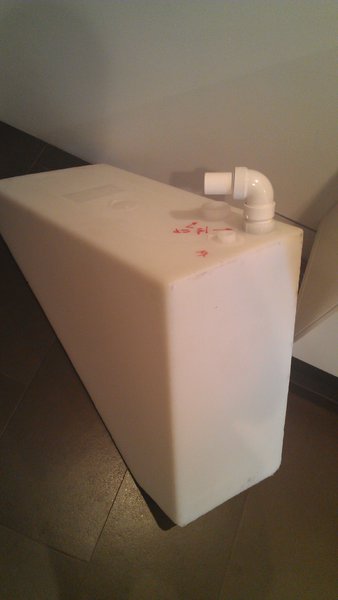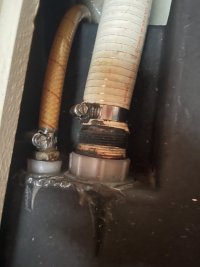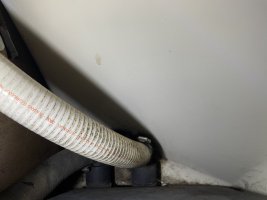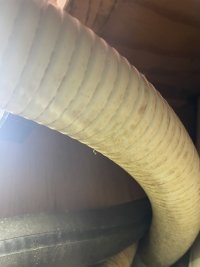You are using an out of date browser. It may not display this or other websites correctly.
You should upgrade or use an alternative browser.
You should upgrade or use an alternative browser.
Marine Head and Hoses, all Models [Master Thread]
- Thread starter Filkee
- Start date
As Loren said elsewhere, the typical job for a stock head is pretty much the same for most models. Cramped and awkward and smelly.
The first test is a wipe with a damp finger on the hoses. If the finger smells, the hoses are permeated and have to go. Then it's a matter of confirming that the 40-year-old plastic holding tank isn't leaking, and if it is...yeah, that's gonna be fun. And the tank air vent hose is equally important. As are the many possible in-line valves, which if frozen make pump-out stations a hassle. When the head area is later sterilized with household cleaner, all smell should be actually, provably, gone. So the goal is real, and worth the work. Then empty the holding tank soon after using it, it isn't designed to be Fort Knox for excrement.
Nobody in his right mind uses perfumed chemicals in holding tanks anymore, as they fill the boat with the atmosphere of a trench on the Western Front in 1916. Odorlos or similar is the current vogue. But pump it out, no microbe is perfect.
 ericsonyachts.org
ericsonyachts.org
Although Erik (Filkee) is in fresh water, boats in some lake environments also profit from the simple conversion to freshwater flush. And then there is the question of a vented loop, which keeps the toilet from overflowing when heeled (or just close the seacock).
 ericsonyachts.org
ericsonyachts.org
Here are some blogs: https://ericsonyachts.org/ie/ubs/categories/sanitation-systems.44/ , including

 ericsonyachts.org
ericsonyachts.org
 ericsonyachts.org
ericsonyachts.org
 ericsonyachts.org
ericsonyachts.org
The first test is a wipe with a damp finger on the hoses. If the finger smells, the hoses are permeated and have to go. Then it's a matter of confirming that the 40-year-old plastic holding tank isn't leaking, and if it is...yeah, that's gonna be fun. And the tank air vent hose is equally important. As are the many possible in-line valves, which if frozen make pump-out stations a hassle. When the head area is later sterilized with household cleaner, all smell should be actually, provably, gone. So the goal is real, and worth the work. Then empty the holding tank soon after using it, it isn't designed to be Fort Knox for excrement.
Nobody in his right mind uses perfumed chemicals in holding tanks anymore, as they fill the boat with the atmosphere of a trench on the Western Front in 1916. Odorlos or similar is the current vogue. But pump it out, no microbe is perfect.
1971 E27 head odor…
So this is a new to me boat, I enjoyed my first season of boat ownership here in Milwaukee sailing the Great Lake Michigan! However I did not enjoy the smell of my head, which has been pumped out right when I bought her. The previous owner is a member at my yacht club and he’s very helpful with...
Although Erik (Filkee) is in fresh water, boats in some lake environments also profit from the simple conversion to freshwater flush. And then there is the question of a vented loop, which keeps the toilet from overflowing when heeled (or just close the seacock).
Seawater supply to toilet: is vented loop required?
I am in process of replacing all hoses connected to the toilet and holding tank in my 32-3. Some sources (Peggie Hall) say that there should be a vented loop in the seawater flush line between the head pump and the toilet, but there is none presently. I believe the existing plumbing arrangement...
Here are some blogs: https://ericsonyachts.org/ie/ubs/categories/sanitation-systems.44/ , including
E38-200 - Replacing the Sanitation System
The smell was not bad, but you could kind of notice it. Having been on dozens of boats, I thought it was normal to have a slight “head” odor. The survey revealed what appeared to be a stuck y-valve, and a small sanitary hose leak at a fitting...
New Holding Tank, Piping & Valves
I am about to replace the 20-year-old hoses. They are starting to permeate, and some even have checking in the outer surface layer... :( Our '88 model has the then-standard Ericson "full Monty" waste management system that allows direct overboard via Y-valve, or, into a 15 gallon (Ronco Plastics...
We Didn't Mean to Replace the Holding Tank
Virginia and I purchased a very fine Ericson 34-2 last fall. When we took possession, the head had that certain odor which was never there previously during any of our inspections and sea trials. Time to investigate. We looked under the head cabinet and found the optional Ericson Rube...
Last edited:
If a dedicated diaphragm pump (probably a Whale brand) is installed to pump waste overboard, it may well be worn out by now.
The consensus seems to be replace, but some are worth rebuilding.
If you don't mind a bit of wiring, a macerator is the ticket for those of us who empty the holding tank beyond the three-mile limit.

 ericsonyachts.org
ericsonyachts.org
The consensus seems to be replace, but some are worth rebuilding.
If you don't mind a bit of wiring, a macerator is the ticket for those of us who empty the holding tank beyond the three-mile limit.
E381 - Macerator and Accumulator Replacement
Ericson 38 sailboat head plumbing macerator replacement Christian Williams Thelonious II
How do you Remove Head Hoses?
Hi folks, Early year project is to replace all the head hoses and replace the PHII pump. My system currently runs from the head to the Y valve underneath the sink, and then out towards the hull, forward to the holding tank in the port V-berth. The deck fitting hose runs out from the holding...
Raritan Head and Plumbing
Hello, Recently bought an Ericson 35-III and noticed an odor (sanitation type) after flushing - coming from outside the boat. After having someone inside flush several times and watching the outside it appears the waste is discharging from the vent well above the water line at the head area...
New Fresh Water Head Flush Installation
It seems to be common knowledge that using fresh water for flushing the head is the best protection against foul odors leaching through plumbing hoses. A few different arrangements have been used for accomplishing that in boats like ours, including: 1.) Replace the traditional head with one...
peaman
Sustaining Member
I replaced all of my hoses two years ago, and along with a unique fresh-water flush solution, all prior issues (except for small space) are resolved. Before ripping out hoses, I suggest carefully documenting how everything is installed, like which hose is above or below, or left or right of another. I didn't do that, and so had to spend some extra time figuring out the best routing of hoses to minimize low spots.Is there a thread that is 32-3 specific? Its hose time for me.
One weak point in the arrangement of tank and hoses is that both waste-in and waste-out hoses have threaded connections at the bottom of the tank. Everything is plastic, so there is a limit to how much you can tighten those fittings. Combined with the long and stiff hoses needed, it is easy to loosen the threaded connections during installation, with the possible result of an inaccessible leak. In order to mitigate that, I put an elbow fitting in each of those hoses about 24" or 30" up from the bottom. Originally those hoses ran unbroken to their respective connections. The hoses pass through an opening in the bulkhead between V berth and head. I used a coarse wood rasp to slightly enlarge, and shape the bulkhead to provide an easier path for the hoses. Also, after everything had been removed from the head cabinet, I painted everything I could reach with Interlux Brightside.
The Whale Gusher manual pump had some minor corrosion near the internal valves, so I cleaned, primed, and painted those areas before rebuilding the pump.
Originally the seat on my fixture was about 1/2" from the salon bulkhead, which seemed wrong to me. I found that by simply moving the head pump to the opposite (aft) side, the head would be centered in the available space, which to me feels much more "normal" (see pictures in link above).
Photos of plumbing of Typical E381 with macerator:
 ericsonyachts.org
ericsonyachts.org
Head (toilet) Hose Connections Ericson 381
Here is what I believe to be Ericson factory connections. Those who wonder why anybody would bother to post this for posterity can harken back to Easter Day, 2020, when the Covid 19 plague closed society and nobody had anything better to do. A (photo below): Left hose goes to holding tank...
Filkee
Sustaining Member
On closer examination, I think I need to do the full Monty here. Whale Gusher connected and capped on one side (nice place for things to grow). Way too much glue around the connections at the top of the tank. And enough dark places down below that I know I need to pull the tank and if I do that, I might as well swap it. So this begs two questions. 1) How do I get the top plate out of the 32-3 v-berth? Does the trim have to come out or will I be able to pull it out once the 30 or so screws are loose? 2) Is that triangle tank a standard item? Does someone have a preferred vendor in New England? Gonna be the best winter ever. Wait, that’s four questions.Is there a thread that is 32-3 specific? Its hose time for me.
peaman
Sustaining Member
I was able to remove the tank through the opening provided only after removing the "cleats" which support the smaller removable cover. After reinstalling the tank, I made new cleats and secured them with screws so they can easily removed in the future. The opening is very tight and I considered enlarging it, but decided against that. I cut the two bottom-connected hoses to ease removal. I also fabricated a webbing harness with a strap across the top of the tank so that the tank can be more easily removed and installed. That allowed me to easily temporarily install the tank for checking dimensions and routing of hoses. I reused my tank after thoroughly flushing it out.How do I get the top plate out of the 32-3 v-berth? Does the trim have to come out or will I be able to pull it out once the 30 or so screws are loose?
The Whale pump is for the bilge, no? I like to have that working, it pumps a lot of water when needed.
Ah, of course. Perhaps you have the optional tank pump-out plumbing? (My 32-3 had no Whale in the head).
Filkee
Sustaining Member
There’s barely room for a trout in the head.Ah, of course. Perhaps you have the optional tank pump-out plumbing? (My 32-3 had no Whale in the head).
Filkee
Sustaining Member
Okay, assuming I can get it out without removing the big part, my next thoughts are to hoses. It appears there are three types in my setup. Most runs are the white stuff off the shelf at west marine. The vent is basic water line (should I be using something better?) and the run from the tank to the deck is black and looks like something that would be part of my cooking system. If I’m going to the trouble, I want to use good materials. Any brand evangelists out there?I was able to remove the tank through the opening provided only after removing the "cleats" which support the smaller removable cover. After reinstalling the tank, I made new cleats and secured them with screws so they can easily removed in the future. The opening is very tight and I considered enlarging it, but decided against that. I cut the two bottom-connected hoses to ease removal. I also fabricated a webbing harness with a strap across the top of the tank so that the tank can be more easily removed and installed. That allowed me to easily temporarily install the tank for checking dimensions and routing of hoses. I reused my tank after thoroughly flushing it out.


Attachments
I believe that presently the Raritan "sani-flex" product is considered to be the best.
Bolo
Contributing Partner
Filkee, May I suggest that you pump out the tank, of course, but also refill it from the deck outlet and pump out again and then maybe do this process one more time or more. Also about five or six bowl fulls of fresh water to clear the hose from the head to the tank. In other words do the old “rinse and repeat” if your pump out location allows it. Just tell them what you’re planning on doing and I’m sure they’ll understand. Will your olfactory system be violated? Yes, probably, but not as bad as if you didn’t flush the tank. Then wear, good gloves, patience and the understanding that this project will take longer than expected. A second person to fetch tools an offer moral support (Like, Go Filkee go!) will be a big help too. I‘ve changed out, over the years, my head, hoses and waste tank. In my case it helped that I was involved in raising two young children (now adults) where hands on diaper changing was a requirement. Good luck!
Well now, That kinda puts boat maintenance into perspective!I‘ve changed out, over the years, my head, hoses and waste tank. In my case it helped that I was involved in raising two young children (now adults) where hands on diaper changing was a requirement.
Filkee
Sustaining Member
I taisef two kids AND oversaw the upgrade of a municipal wastewater plant so the gross factor is not that bad for me. I like the idea of a witness though. Thought I’d try to pull everything next week and spend the winter contemplating a better world. Getting new cushions too.
Just confirming that them hoses--they stink, right? It's an optical illusion that they look awful shiny, nicht war? But clearly when you rub a damp rag on them and smell it it has the nose not of a fine cabernet but of Bolo's diaper hamper, eh? My stinky hoses were black and permeated. But stink is subjective, yes. Napoleon, sending a message to Josephine of his imminent arrival home, said simply "I am coming. Don't wash."

